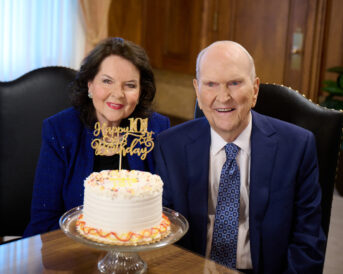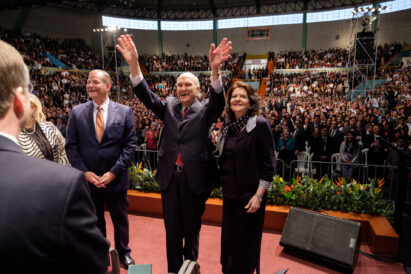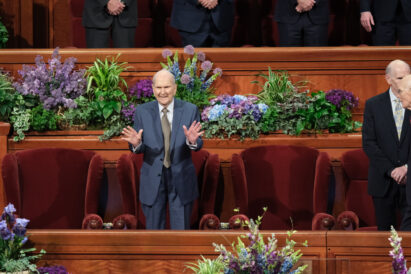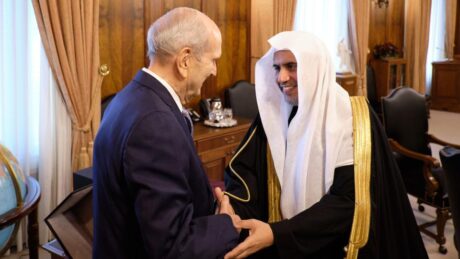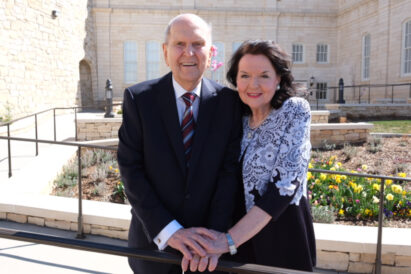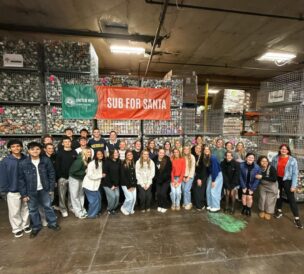Russell M. Nelson, president of The Church of Jesus Christ of Latter-day Saints, dies at 101
- Russell M. Nelson, president of the Church of Jesus Christ of Latter-day Saints, celebrates his 101st birthday with his family on Tuesday, Sept. 9, 2025.
- The Church of Jesus Christ of Latter-day Saints president Russell M. Nelson meets Pope Francis at the Vatican in 2019.
- Russell M. Nelson, president of The Church of Jesus Christ of Latter-day Saints, waves to the audience at the Conference Center in Salt Lake City in October 2018.
- Russell M. Nelson, president of The Church of Jesus Christ of Latter-day Saints, shakes the hand of a little girl at the conclusion of the afternoon session of general conference at the Conference Center in Salt Lake City on Sunday, April 6, 2025.
- Russell M. Nelson, president of The Church of Jesus Christ of Latter-day Saints, speaks at the conclusion of general conference during the afternoon session at the Conference Center in Salt Lake City on Sunday, April 6, 2025.
- Russell M. Nelson, center, president of The Church of Jesus Christ of Latter-day Saints, with his counselors in the First Presidency, President Dallin H. Oaks, left, and President Henry B. Eyring, right, prior to the afternoon session of general conference at the Conference Center in Salt Lake City on Sunday, April 6, 2025.
- Russell M. Nelson, president of The Church of Jesus Christ of Latter-day Saints, gestures prior to the afternoon session of general conference at the Conference Center in Salt Lake City on Sunday, April 6, 2025.
- President Russell M. Nelson of The Church of Jesus Christ of Latter-day Saints greets His Excellency Dr. Mohammad Abdulkarim Al-Issa, secretary-general of the Muslim World League, on Nov. 5, 2019.
- President Russell M. Nelson and his wife Wendy participate in the rededication of the Manti Utah Temple on Sunday, April 21, 2024.
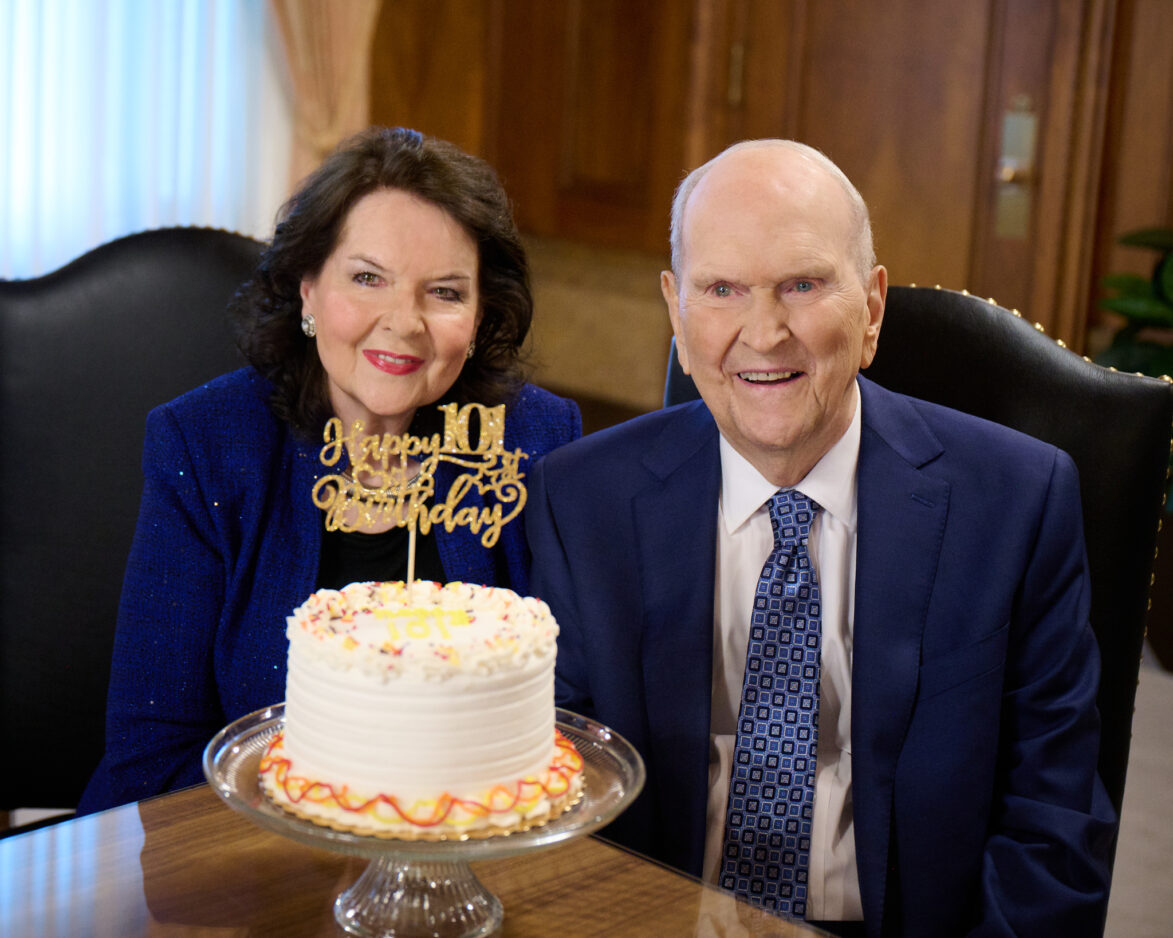
Courtesy The Church of Jesus Christ of Latter-day Saints
Russell M. Nelson, president of the Church of Jesus Christ of Latter-day Saints, celebrates his 101st birthday with his family on Tuesday, Sept. 9, 2025.
President Russell M. Nelson leaves a legacy of touching hearts.
He was an internationally acclaimed heart surgeon, but it was the way he touched people’s hearts with his love and testimony that made Nelson a friend to thousands around the world.
Nelson, the 17th president in the history of The Church of Jesus Christ of Latter-day Saints and the one who had lived the longest, died Saturday in Salt Lake City at age 101, according to news release from the church
“With sorrow we announce that Russell M. Nelson, beloved President of The Church of Jesus Christ of Latter-day Saints, passed away peacefully shortly after 10 p.m. MDT today at his home in Salt Lake City,” the release stated.
Nelson was born Sept. 9, 1924, the son of Marion C. and Edna Anderson Nelson. He and his first wife, the Dantzel White, had 10 children together. Sister Nelson passed away in February 2005. Nelson married Wendy L. Watson in April 2006.
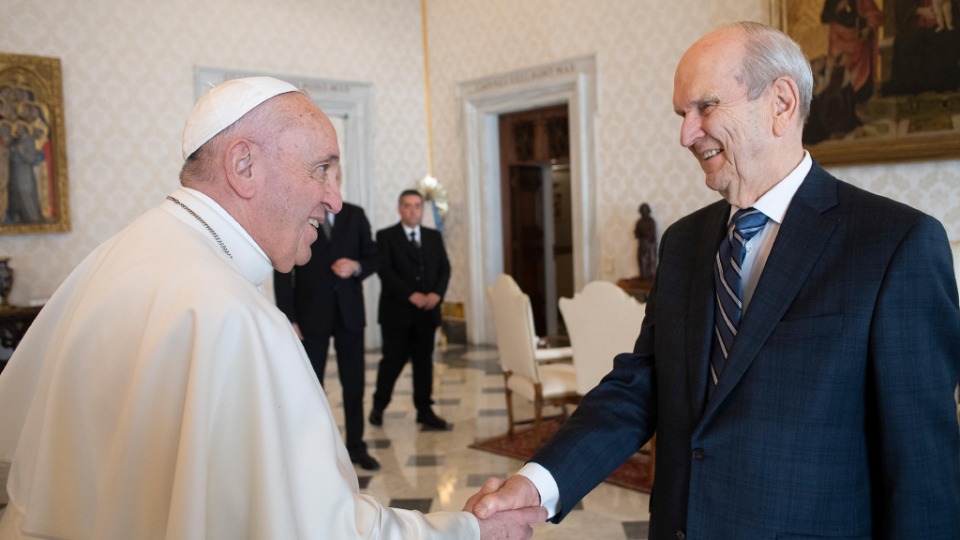
Courtesy Intellectual Reserve
The Church of Jesus Christ of Latter-day Saints president Russell M. Nelson meets Pope Francis at the Vatican in 2019.
Nelson was called as a member of the Quorum of the Twelve Apostles of The Church of Jesus Christ of Latter-day Saints on April 7, 1984. He was set apart as president of the Quorum of the Twelve Apostles on July 15, 2015, following the death of President Boyd K. Packer and became the president of the church on Jan. 14, 2018, succeeding President Thomas S. Monson.
Academic and professional life
Nelson received his B.A. and M.D. degrees from the University of Utah in 1945 and 1947, respectively. His residency in surgery was served at Massachusetts General Hospital in Boston and at the University of Minnesota. He was awarded his Ph.D. in 1954.
Nelson enlisted and served a two-year term of medical duty in the U.S. Army during the Korean War; he served in Korea and Japan and at Walter Reed Army Medical Center in Washington, D.C.
He was a teacher in all aspects of his life. As a surgeon, he served as research professor of surgery and director of the Thoracic Surgery Residency at the University of Utah as well as chairman of the Division of Thoracic Surgery at LDS Hospital in Salt Lake City.
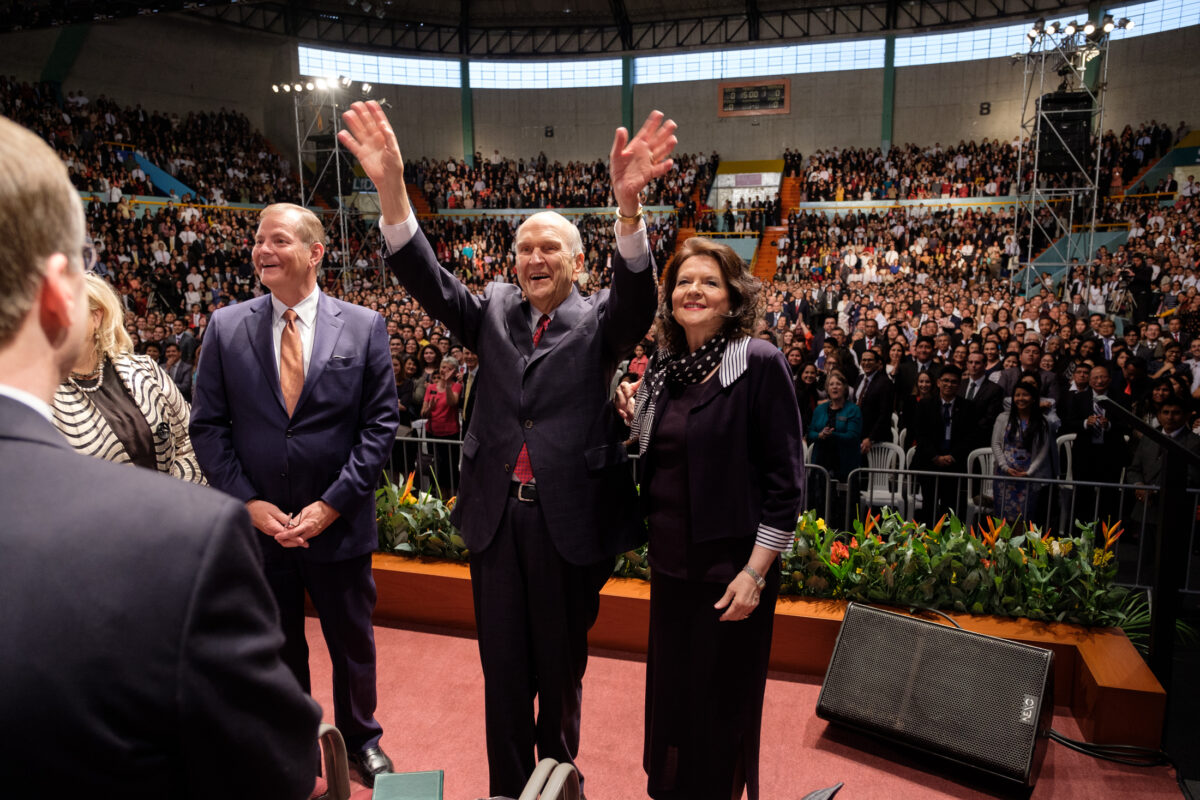
Courtesy the Church of Jesus Christ of Latter-day Saints
Russell M. Nelson, president of The Church of Jesus Christ of Latter-day Saints, waves to the audience at the Conference Center in Salt Lake City in October 2018.
He authored numerous publications and made substantial written contributions in medical textbooks.
Among the contributions to medical science Nelson made during his career was helping to develop the first artificial heart-lung machine. That machine was used during the first open-heart surgery in Utah.
While Nelson performed open-heart surgeries many times, he is most noted for performing open-heart surgery on Spencer W. Kimball, the 12th president of The Church of Jesus Christ of Latter-day Saints.
Nelson lectured around the world and received numerous awards and recognitions, including the Heart of Gold Award from the American Heart Association; a citation for International Service from the American Heart Association; and the Golden Plate Award, presented by the American Academy of Achievement.
He was also awarded honorary professorships from three universities in the People’s Republic of China. He spoke Mandarin fluently. In 2021, he received an honorary degree from the University of Utah.

Courtesy Intellectual Reserve
Russell M. Nelson, president of The Church of Jesus Christ of Latter-day Saints, shakes the hand of a little girl at the conclusion of the afternoon session of general conference at the Conference Center in Salt Lake City on Sunday, April 6, 2025.
Nelson served as president of the Society for Vascular Surgery, a director of the American Board of Thoracic Surgery, chairman of the Council on Cardiovascular Surgery for the American Heart Association and president of the Utah State Medical Association.
Church participation and service
According to an article titled “President Russell M. Nelson: Guided, Prepared, Committed” on the church’s website written by President Dallin H. Oaks of the First Presidency, Nelson’s baptism came later than many other children in the church.
“Both parents were less-active members of the Church throughout Russell’s childhood, but they showered their children with love and occasionally sent them to Sunday School,” the article read. “Initially, young Russell was not interested in church, preferring to play football with his friends. But when he turned 16, his heart began to respond to the truths of the gospel and he was baptized along with his siblings. Years later, because of the example and persuasion of their children, the Nelson parents returned to activity.”
Nelson served in bishoprics and high councils and was called to serve as stake president of the Bonneville Stake from 1964 to June 1971, after which he was called as general president of the Sunday School. Before his calling to the Quorum of the Twelve, he served as a regional representative for the Kearns Utah Region. Before that, he had served as regional representative for Brigham Young University.

Courtesy Intellectual Reserve
Russell M. Nelson, president of The Church of Jesus Christ of Latter-day Saints, speaks at the conclusion of general conference during the afternoon session at the Conference Center in Salt Lake City on Sunday, April 6, 2025.
As an apostle and president of the Quorum of the Twelve, Nelson traveled to the four corners of the earth preaching, teaching and training local leaders as The Church of Jesus Christ of Latter-day Saints continues to have a growing membership.
One of his first acts after becoming president of the church was to take a world tour, spanning 16 nations and territories in his first year as prophet. Included in his tour was a speaking event at Seattle’s T-Mobile Park, then called Safeco Field, the home of the Seattle Mariners baseball team, on Sept. 15, 2018. Speaking from a stage arranged at second base, Nelson addressed nearly 50,000 people, making it the largest nonsporting event in the baseball stadium’s then 19-year history.
Since that time, he has visited nearly every quadrant of the globe to meet with church members, local leaders and government officials.
During his time as prophet, Nelson announced 200 temples to be built, some in unique places, including a yet-to-be-announced city in Russia, Shanghai, Dubai, India, Mongolia, several African countries and many locations in the United States.
During 2019 and 2020, temples closed and then had phased reopenings around the world due to the COVID-19 pandemic. On several occasions, Nelson encouraged members around the world to follow doctor’s instructions and when vaccines were made available to be immunized.

Courtesy Intellectual Reserve
Russell M. Nelson, center, president of The Church of Jesus Christ of Latter-day Saints, with his counselors in the First Presidency, President Dallin H. Oaks, left, and President Henry B. Eyring, right, prior to the afternoon session of general conference at the Conference Center in Salt Lake City on Sunday, April 6, 2025.
The most notable temple experience during Nelson’s time as the prophet was the open house and dedication of the Rome Temple. For the first time in church history, all of the members of the Quorum of the Twelve Apostles and the First Presidency were on hand for the event at the request of the prophet.
Nelson also oversaw the re-dedication of the Washington, D.C., temple. He announced that legacy temples would be renovated, and the iconic Salt Lake City Temple started a complete seismic upgrade and rebuild.
He made numerous changes to the youth and children programs and the ability for those in their 12th years but still 11 to attend the temple and be ordained to the Aaronic Priesthood. New goal-setting programs and activities were started as the church broke away from the Boy Scouts of America.
Visiting and home teaching made way for a new “ministering” program, new hymnbooks were announced and special projects were started including #HearHim, Let God Prevail and #GiveThanks. On Nov. 20, 2020, Nelson delivered a video message on “the healing power of gratitude” that was shared on YouTube. The nearly 12-minute video has been viewed over 12.7 million times.
The church introduced a new logo featuring the resurrected Christ, while many of the new temples no longer feature the statue of Moroni on their spires. The church’s focus was to be Christ-centered, to gather Israel “on either side of the veil,” as Nelson once stated, and to prepare for the second coming of Christ.
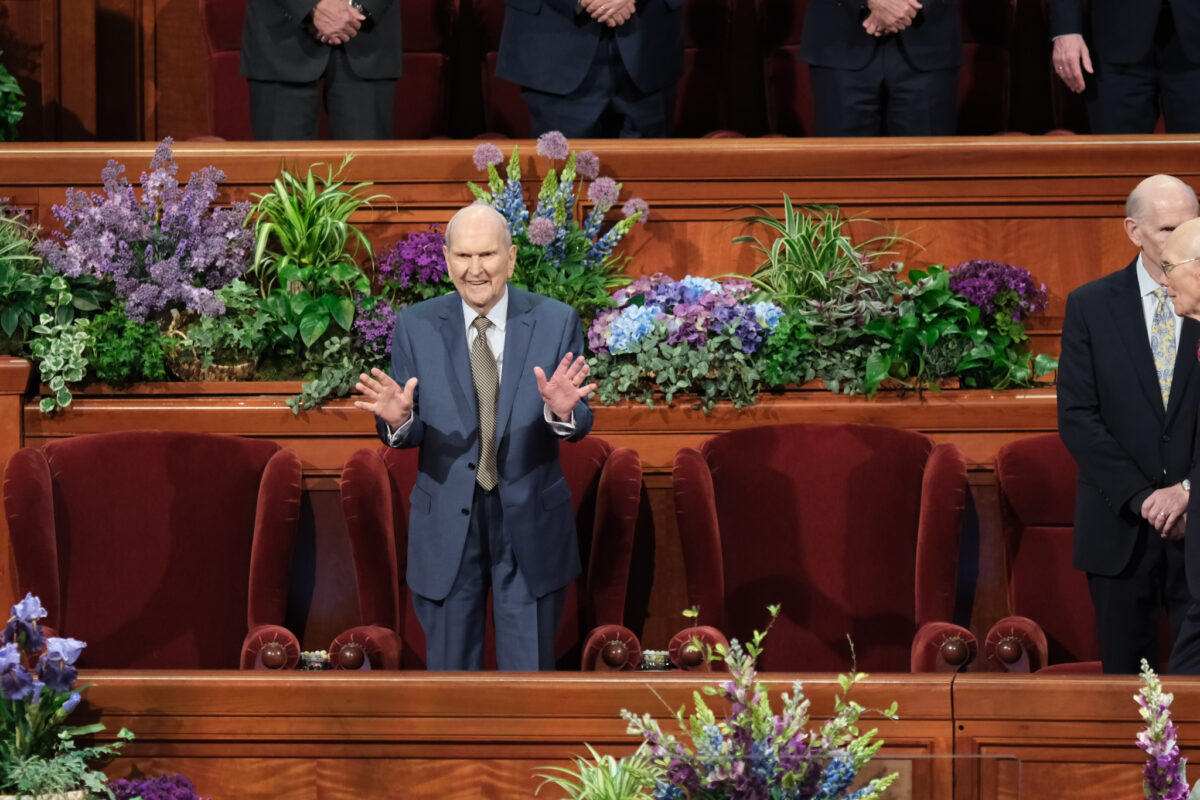
Courtesy Intellectual Reserve
Russell M. Nelson, president of The Church of Jesus Christ of Latter-day Saints, gestures prior to the afternoon session of general conference at the Conference Center in Salt Lake City on Sunday, April 6, 2025.
Legacy
In a general conference address in April 2023, Nelson stressed the importance of being a peacemaker. Nelson showed that he practiced what he preached, forging a relationship with the NAACP.
In May 2018, just a few months after Nelson became president of The Church of Jesus Christ of Latter-day Saints, the First Presidency as well as NAACP leaders issued statements showing solidarity from the Latter-day Saint Church Administration Building in Salt Lake City.
“Today, in unity with such capable and impressive leaders as the national officials of the NAACP, we are impressed to call on people of this nation, and indeed, the entire world, to demonstrate greater civility, racial and ethnic harmony, and mutual respect,” Nelson said, according to an article by Church News.
NAACP President and CEO Derrick Johnson was quoted in the article as saying:

Courtesy Intellectual Reserve.
President Russell M. Nelson of The Church of Jesus Christ of Latter-day Saints greets His Excellency Dr. Mohammad Abdulkarim Al-Issa, secretary-general of the Muslim World League, on Nov. 5, 2019.
“I am proud to stand here today, to open up a dialogue, to seek ways of common interest, to work toward a higher pursuit. This is a great opportunity. Thank you for this moment.”
According to the article, Johnson and other NAACP leaders were in Salt Lake City “for quarterly meetings of the 109-year-old organization’s 65-member board.” The article further stated that it marked the first time the NAACP had held leadership meetings in Utah.
Nelson established a relationship specifically with the Rev. Dr. Amos Brown of the Third Baptist Church of San Francisco, who called Nelson “a brother from another mother” when introducing him to NAACP members in 2019 in Detroit.
“Arm in arm and shoulder to shoulder, may we strive to lift our brothers and sisters everywhere, in every way we can. This world will never be the same,” Nelson said in his address to the NAACP.
During a ceremony on Sept. 9, 2024, commemorating Nelson’s 100th birthday, Brown provided a video tribute to Nelson in which he referenced his introduction of Nelson.

Courtesy Intellectual Reserve.
President Russell M. Nelson and his wife Wendy participate in the rededication of the Manti Utah Temple on Sunday, April 21, 2024.
“And when I introduced him, I introduced him as my brother of another mother, and I meant that,” Brown said. “Because I felt that kindred spirit immediately when I met him. And he came with a track record of leading The Church of Jesus Christ of Latter-day Saints to higher pursuits of racial reckoning, understanding and working to provide a better day for all of God’s children, particularly those who lived in urban communities around this nation.”
Brown said that Nelson has “led The Church of Jesus Christ of Latter-day Saints through unparalleled accomplishments of humanitarian, spiritual, cultural and social betterment in this nation and world” and that “it goes without saying (Nelson) has justified his existence in this world,” that “he did not just exist.”
Among the tributes given to Nelson at his 100th birthday celebration was one by President Jeffrey R. Holland, acting president of the Quorum of the Twelve Apostles, who spoke on behalf of the Quorum of the Twelve Apostles.
“Surely, history will note that of the many marvelous characteristics visible in the Nelson administration, one quality that was almost invisible was the warm and productive unity that Russell M. Nelson maintained between the First Presidency and the Quorum of the Twelve Apostles,” Holland said.
Holland said he and his wife had a close relationship with Nelson and his family for almost 50 years.
“One endearing event the Hollands have never forgotten was when our youngest son David was baptized in the river Jordan in the holy land,” Holland said. “At that precious experience, we needed a photographer to get a photo for the family record. Well, this Ansel Adams of Judeah was, of course, the multitalented Russell M. Nelson, who not only took a dozen photos for us but also prepared and delivered a second set to my beloved mother, whom he knew from far off St. George, Utah.
“When I came into the Quorum of the Twelve some two decades later, my mother wept and hugged me and then told me I was her second favorite apostle. I don’t have to tell you who was number one.”
Holland heralded Nelson’s musical and language talents as well as his personal and spiritual qualities.
“In his effort to hasten the work, he’s been the Lord’s mouthpiece in receiving and implementing a veritable ‘rush of revelation’ as I once called it,” Holland said. “He is unfailingly kind and composed, gentle and forgiving. Above all, he has embraced and personifies the counsel Paul gave to the Corinthians. ‘Do ye not know that they which minister holy things should live the things of the temple.'”
Ashlyn Owens, Nelson’s great-granddaughter, highlighted three attributes she loved the most about him at his 100th birthday celebration.
First, she highlighted his love for his family.
“I will always think of his love when I think of him,” she said. “From his love to his personalized nicknames, he has always been full of love.”
Second, she spoke of his steadfastness.
“Despite serving in a myriad of callings, he has hardly ever missed a baby blessing, a baptism, mission call opening or special family event,” she said. “Our family has become very large, but he has always focused on us as individuals.”
To emphasize the point, Owens spoke of a time when she was a teenager and was struggling with her faith.
“I was invited to attend general conference, and the minute my father entered the room, his eyes sought me out,” she said. “I locked eyes on him (and) felt his undeniable love and support. I don’t think he explicitly knew I was struggling, but his gentle dependability was grounding for a young, unsure girl. I could tangibly feel a solid wave of encouragement remind me that he was proud of me and that he loved me even when I was struggling.”
Third, she spotlighted his respect for women.
“He has said, ‘The heavens are just as open to women as they are to men,'” she said. “He has taught that ‘The kingdom of God is not and cannot be complete without women.’ He is proud to exclaim that ‘we need women who have the courage and vision of our mother Eve.’ He loves and respects men and women equally.”
Themes
A theme of Nelson’s tenure as the president of The Church of Jesus Christ of Latter-day Saints was the focus put on covenants.
During an October 2011 general conference address, Nelson explained covenants in the following way:
“One of the most important concepts of revealed religion is that of a sacred covenant. In legal language, a covenant generally denotes an agreement between two or more parties. But in a religious context, a covenant is much more significant. It is a sacred promise with God. He fixes the terms. Each person may choose to accept those terms. If one accepts the terms of the covenant and obeys God’s law, he or she receives the blessings associated with the covenant. We know that ‘when we obtain any blessing from God, it is by obedience to that law upon which it is predicated.’ (Doctrine and Covenants 130:21)
“Through the ages, God has made covenants with his children. (Genesis 9) His covenants occur throughout the entire plan of salvation and are therefore part of the fulness of His gospel. (Doctrine and Covenants 66:2; Doctrine and Covenants 133:57) For example, God promised to send a Savior for His children, (John 3:16) asking in turn for their obedience to His law. (Abraham 3:25)”
Nelson used the phrase “covenant path” during a live broadcast from the Salt Lake Temple’s annex on Jan. 16, 2018, two days after he was set apart as the prophet, and the remarks that he gave, which included the phrase, were published as the First Presidency message in the April 2018 issue of the Ensign.
In his remarks, he said:
“Now, to each member of the Church I say, keep on the covenant path. Your commitment to follow the Savior by making covenants with Him and then keeping those covenants will open the door to every spiritual blessing and privilege available to men, women, and children everywhere.
“As a new Presidency, we want to begin with the end in mind. For this reason, we’re speaking to you today from a temple. The end for which each of us strives is to be endowed with power in a house of the Lord, sealed as families, faithful to covenants made in a temple that qualify us for the greatest gift of God — that of eternal life. The ordinances of the temple and the covenants you make there are key to strengthening your life, your marriage and family, and your ability to resist the attacks of the adversary. Your worship in the temple and your service there for your ancestors will bless you with increased personal revelation and peace and will fortify your commitment to stay on the covenant path.
“Now, if you have stepped off the path, may I invite you with all the hope in my heart to please come back. Whatever your concerns, whatever your challenges, there is a place for you in this, the Lord’s Church. You and generations yet unborn will be blessed by your actions now to return to the covenant path. Our Father in Heaven cherishes His children, and He wants each of us to return home to Him. This is a grand goal of The Church of Jesus Christ of Latter-day Saints–to help each of us to come back home.”
According to Brigham Young University professor Kerry Muhlestein: “The covenant path consists of making and keeping the covenants the Lord has asked us to make, and then being worthy of continually renewing that covenant. We make covenants at baptism and in the temple. We renew those covenants weekly as we partake of the sacrament. You are on the covenant path if you are keeping covenants you have made and are working towards making the next covenant available to you, or are worthy of renewing the covenants you have already made.”
Following Nelson’s remarks, the phrase “covenant path” became common in general conference addresses. After being used just 18 times in general conference addresses prior to Nelson becoming church president, the first coming during an April 2007 address by Elaine S. Dalton titled “Stay on the Path” as she quoted 2006 remarks by Holland, the phrase has been used in over 100 addresses since.
Nelson will also be remembered for his focus on using the full name of The Church of Jesus Christ of Latter-day Saints rather than commonly used nicknames like “Mormon” or “LDS.”
During an October 2018 general conference address, he elaborated, saying (as reported in a transcript):
“Some weeks ago, I released a statement regarding a course correction for the name of the Church. I did this because the Lord impressed upon my mind the importance of the name he decreed for His Church, even The Church of Jesus Christ of Latter-day Saints.
“As you would expect, responses to this statement and to the revised style guide have been mixed. Many members immediately corrected the name of the church on their blogs and social media pages. Others wondered why, with all that’s going on in the world, it was necessary to emphasize something so ‘inconsequential.’ And some said it couldn’t be done, so why even try? Let me explain why we care so deeply about this issue. But first let me state what this effort is not:
- “It is not a name change.
- “It is not rebranding.
- “It is not cosmetic.
- “It is not a whim.
- “And it is not inconsequential.
“Instead, it is a correction. It is the command of the Lord. Joseph Smith did not name the Church restored through him; neither did Mormon. It was the savior himself who said, ‘For thus shall my church be called in the last days, even The Church of Jesus Christ of Latter-day Saints.'”
He continued:
“Even earlier, in AD 34, our resurrected Lord gave similar instruction to members of His Church when he visited them in the Americas. At that time, he said:
“‘Ye shall call the church in my name. …
“‘And how be it my church save it be called in my name? For if a church be called in Moses’ name then it be Moses’ church; or if it be called in the name of a man then it be the church of a man; but if it be called in my name then it is my church.’
“Thus, the name of the Church is not negotiable. When the savior clearly states what the name of his church should be and even precedes his declaration with, “Thus shall my church be called,” he is serious. And if we allow nicknames to be used or adopt or even sponsor those nicknames ourselves, he is offended.
“What’s in a name or, in this case, a nickname? When it comes to nicknames of the church, such as the ‘LDS Church,’ the ‘Mormon Church,’ or the ‘Church of the Latter-day Saints,’ the most important thing in those names is the absence of the savior’s name. To remove the Lord’s name from the Lord’s Church is a major victory for Satan. When we discard the savior’s name, we are subtly disregarding all that Jesus Christ did for us — even his atonement.”
Strengthening his reasoning, Nelson included the following in the footnotes of his talk:
“Preceding presidents of the church have made similar requests. For example, President George Albert Smith said: ‘Don’t let the Lord down by calling this the Mormon Church. He didn’t call it the Mormon Church.'”
Subsequently, mobile apps, web addresses, LDS Charities, LDS Family Services, Mormon Channel, even its wireless network and most notably, the Mormon Tabernacle Choir, were all renamed to remove the terms “Mormon” and “LDS.”
According to a church statement on Aug. 16, 2019, “Today marks one year since President Russell M. Nelson announced the faith’s intention to improve usage of the correct name of the Church. Since then, the Church has corrected its name in the email addresses of 33,000 leaders and employees, has updated 300 web-based apps and has changed 95 percent of the outward-facing references to its name.”

